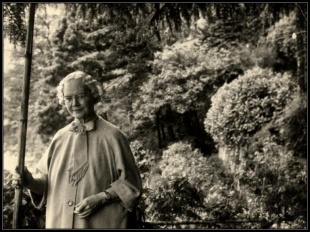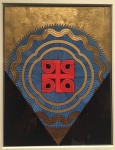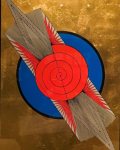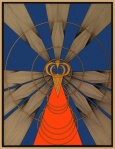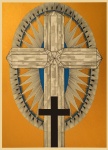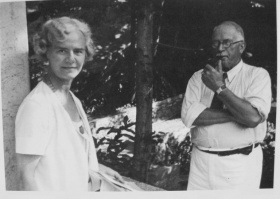Olga Fröbe-Kapteyn: Difference between revisions
No edit summary |
No edit summary |
||
| (9 intermediate revisions by the same user not shown) | |||
| Line 1: | Line 1: | ||
[[File:Olga Frobe-Kapteyn.jpg|right|310px|thumb|Olga Fröbe-Kapteyn]] | [[File:Olga Frobe-Kapteyn.jpg|right|310px|thumb|Olga Fröbe-Kapteyn]] | ||
'''Olga Fröbe-Kapteyn''' (19 October 1881 – 1962) was a Dutch artist and theosophist. She is best known as the founder of the Eranos Foundation that holds annual | '''Olga Fröbe-Kapteyn''' (19 October 1881 – 1962) was a Dutch artist and [[theosophist]]. She is best known as the founder of the Eranos Foundation that holds annual conferences of scholars. | ||
== Family and education == | |||
== | |||
[[ | Olga Kapteyn was born in London on [[October 19]], 1881. | ||
< | <blockquote> | ||
< | Olga Fröbe-Kapteyn, the daughter of Dutch parents, was interested in iconography right from her childhood, when she watched, fascinated, as her father Albertus Philippus Kapteyn (or Kapteijn) developed photographic film in his darkroom. Her mother, Geertruida (Truus) Agneta Kapteyn-Muysken, was involved in female emancipation and social-reform movements. In 1900, O. Fröbe-Kapteyn began studying at the School of Applied Arts in Zurich, excelling at sewing, embroidery, and jewelry-making. She studied history of art at the University of Zurich from 1906 to 1909. | ||
In 1909, she married the flautist and conductor Iwan Fröbe. After a visit to Munich, the Fröbes spent time in Berlin with the philologist André Jolles, who had set up the Needle sewing circle in 1911. O. Fröbe-Kapteyn decorated the clothes that Jolles created, inspired by classical Greece, with exquisite embroidery. Widowed in 1915, she organized a cultural circle in Zurich, and in 1919–20 followed a course of natural treatment at the Monte Verità sanatorium in Ascona. In 1920, she moved to the Casa Gabriella in Ascona, where she spent a period of ‘concentration discipline’ during which, with her daughter as her sole companion, she devoted herself to the study of spirituality.<ref>[https://awarewomenartists.com/en/artiste/olga-frobe-kapteyn/ Olga Fröbe-Kapteyn] at awarewomenartists.com.</ref> | |||
</blockquote> | |||
== Life and work == | |||
The New Museum in New York presented an exhibition that included "meditation drawings" by Olga Fröbe-Kapteyn, that were on loan from the Eranos Foundation collection. A sign from the exhibition summarized her life work: | |||
<blockquote> | |||
As a spiritualist and researcher in the early twentieth century, Olga Fröbe-Kapteyn was fascinated by the prospect of assimilating esoteric, humanistic, and scientific knowledge. In 1930, she enlisted English Theosophist [[Alice Bailey]] (1880-1949) to help establish a school of spiritual research on her estate in Ascona, Switzerland, and, following Bailey’s methods of psychotherapy, she started to produce a number of remarkably precise and angular artworks she referred to as “meditation drawings,” which combine the accelerated energy of Futurism with a cryptic semiotics. | |||
Within a few years, Fröbe-Kapteyn sought to establish a more interdisciplinary research institute and began an influential annual lecture series known as the Eranos conferences. Beginning in 1933, these conferences | |||
brought together international historians, theologians, scientists, mythologists, and psychologists to discuss human nature and the histories of religion and world cultures. Foremost among participating thinkers was Swiss psychologist Carl Jung (1875-1961), who became an influential collaborator as the Eranos conference topics began to dovetail with his research into universal symbols and archetypes. | |||
In 1935, Fröbe-Kapteyn set out to create an image archive that would complement Jung’s writings, and, as she phrased it, she started “picture-hunting everywhere,” combing major libraries and collections across Europe | |||
for archetypal depictions in archaic statuary, fine art, and sacred architectural reliefs. Her “Eranos Archive,” later known as ARAS (Archive for Research in Archetypal Symbolism), began as a collection of around six thousand images classified according to various themes. Her iconographic study of great goddesses in various cultures was first exhibited as part of the 1938 Eranos conference, titled “The Great Mother,” and included images of important goddesses that appear in statues from Aztec, Minoan, and Babylonian | |||
civilizations, among many others, which are re-collected and presented in “The Keeper” as slides. Like Jung, Fröbe-Kapteyn believed that the power of these shared symbols and archetypes rests in the fact that they reveal aspects of the human psyche and experience that transcend time and cultures.<ref>Natalie Bell, sign from The New Museum exhibition "The Keeper." 2016. See [https://www.newmuseum.org/exhibitions/view/the-keeper The Keeper] at The New Museum website. Text quoted by John L. Crow in email to Janet Kerschner, September 26, 2016. Theosophical Society in America Archives.</ref> | |||
</blockquote> | |||
She died at her home, Casa Gabriella, in 1962. | |||
== Art == | == Art == | ||
< | |||
< | The paintings of Olga Fröbe-Kapteyn exhibit great precision in their geometric shapes. She used a limited color palette - predominately red, blue, gold, and black. "Their rigid geometry and complete lack of naturalism are reinforced by the choice of predominantly cold colours, with a basic dialectic between black (shade, negative, death) and gold (light, positive, life). The result is an abstractionism expressing a spirituality stripped of any corporality."<ref>[https://awarewomenartists.com/en/artiste/olga-frobe-kapteyn/ Olga Fröbe-Kapteyn] by Fabio Merlini and Riccardo Bernardini, translated from French by Thames & Hudson Ltd. 2021.</ref> | ||
< | |||
< | Here are some examples of her art: | ||
== Eranos Foundation == | |||
[[File:Olga Frobe-Kapteyn with Carl Jung at Eranos.jpg| | <gallery widths="130px" heights="150px" perrow="5"> | ||
< | File:Swastika Meditation Drawing.jpg|<center>Swastika Meditation Drawing</center> | ||
< | File:Frobe-Kapteyn Untitled.png|<center>"Untitled," ca 1927-34</center> | ||
< | File:Art on book cover.jpg|<center>"The Divine Breath" on book cover</center> | ||
< | File:Kether the Crown, 1930.jpg|<center>"Kether the Crown," 1930</center> | ||
< | File:The Cosmic Incarnation,1930.jpg|<center>"The Cosmic Incarnation," 1930</center> | ||
< | </gallery> | ||
< | |||
< | == Eranos Foundation and ARAS == | ||
[[File:Olga Frobe-Kapteyn with Carl Jung at Eranos.jpg|right|280px|thumb|Olga Fröbe-Kapteyn with Carl Jung at Eranos]] | |||
The '''Eranos Society''', later known as the '''Eranos Foundation''', began meeting each year in late August at the estate of Olga Fröbe-Kapteyn at Lake Maggiore in southern Switzerland, beginning in 1933. The name "Eranos" (Greek for "banquet") was proposed by the historian of religion Rudolf Otto. She invited eminent participants such as: | |||
* Heinrich Zimmer (Indian religious art) | |||
* Károly Kerényi (Greek mythology) | |||
* Mircea Eliade (history of religions) | |||
* C.G. Jung (analytical psychology), | |||
* Erich Neumann (analytical psychology) | |||
* Gilles Quispel (gnostic studies) | |||
* Gershom Scholem (Jewish mysticism) | |||
* Henry Corbin (Islamic religion) | |||
* Adolf Portmann (biology) | |||
* Herbert Read (art history) | |||
* Max Knoll (physics) | |||
* Joseph Campbell (comparative mythology) | |||
Artistic representations of symbols were a major feature of the early Eranos meetings: | |||
<blockquote> | |||
Olga Froebe-Kapteyn had a lively interest in finding and collecting images to illustrate the topic of each year's meeting, which included such titles as "Yoga and Meditation East and West," "The Gestalt and Cult of the Great Mother," "The Hermetic Principle in Mythology, Gnosis, and Alchemy," "The Mysteries," "Spirit and Nature," "Man and Time," and many others. She explained this interest in images in her preface to the volume Spirit and Nature (1954): "Those who feel the truth of the old Chinese conception that all that happens in the visible world is the expression of ideas or images in the invisible might do well to consider Eranos from that point of view"<ref>[http://aras.org/about/history-of-aras History of ARAS] by Joseph L. Henderson, quoting ''Man and His Symbols'', page xv.</ref> She might have said of the collection of pictorial artifacts what she says of the lectures themselves: "Their value is evocative. In many cases, they carry us to the bounds of scholarly investigation and discovery, and point beyond. They touch upon unusual themes, facts, and analogies and in so doing evoke the great archetypal images"<ref>[http://aras.org/about/history-of-aras History of ARAS] by Joseph L. Henderson, quoting ''Man and His Symbols'', page xvi.</ref> | |||
</blockquote> | |||
The '''Archive for Research in Archetypal Symbolism (ARAS)''' is available at [https://aras.org/ ARAS.org]. | |||
<blockquote> | |||
The Archive for Research in Archetypal Symbolism (ARAS) is a pictorial and written archive of mythological, ritualistic, and symbolic images from all over the world and from all epochs of human history. The collection probes the universality of archetypal themes and provides a testament to the deep and abiding connections that unite the disparate factions of the human family. | |||
The ARAS archive contains about 18,000 photographic images, each cross-indexed, individually mounted, and accompanied by scholarly commentary. The commentary includes a description of the image with a cultural history that serves to place it in its unique historical and geographical setting. Often it also includes an archetypal commentary that brings the image into focus for its modern psychological and symbolic meaning, as well as a bibliography for related reading and a glossary of technical terms.<ref>[https://aras.org/about About ARAS].</ref> | |||
</blockquote> | |||
Dr. Joseph L. Henderson, co-author with Dr. Carl Gustav Jung of ''Man and His Symbols'', wrote about the history of ARAS: | |||
<blockquote> | |||
A number of original illustrations of ancient symbolic artifacts were collected by Olga Froebe-Kapteyn at her estate on Lake Maggiore in southern Switzerland, where each year in late August, beginning in 1933, she conducted meetings of the Eranos Society. In his foreword to Spirit and Nature, volume 1 (1954) of the series Papers from the Eranos Yearbooks, Joseph Campbell notes that each meeting was assigned a theme, which served as the topic for papers presented by scientists, theologians, philosophers, psychologists, and religious historians. "Continuity was due, on the one hand, to the guidance of Frau Froebe, whose sense of the meaning and object of Eranos never wavered [even during the years of World War II when the operation was greatly curtailed—JLH], and on the other, to the continuous presence and genial spirit of Dr. C.G. Jung, whose concept of the fundamental psychological laws of human life and thought supplied a criterion for both the recognition and the fostering of the perennial in a period of transition"<ref>[http://aras.org/about/history-of-aras History of ARAS] by Joseph L. Henderson, quoting ''Man and His Symbols'', page xii.</ref> | |||
</blockquote> | |||
<blockquote> | |||
One of the creative uses to which Froebe-Kapteyn's collection was put is Erich Neumann's book The Great Mother: An Analysis of the Archetype (Princeton, 1955), where pictures of ancient goddesses provide the material for Neumann's psychological interpretation of the archetype of the feminine as it evolved from the time of ancient Sumeria and Egypt on through the religions of Greece and Rome and into the Christian era.<ref>[http://aras.org/about/history-of-aras History of ARAS] by Joseph L. Henderson.</ref> | |||
</blockquote> | |||
<blockquote> | |||
In 1946 Olga Froebe-Kapteyn gave her collection of pictorial artifacts to the Warburg Institute in London. Photographic duplicates of the archive were given to the C.G. Jung Institute in Zurich and to the Bollingen Foundation in New York, which was, at that time, supporting numerous scholars in quest of the meaning of symbolism and publishing the works of Jung... | |||
Eventually the collection in New York, now called the Archive for Research in Archetypal Symbolism, was acquired by the C.G. Jung Foundation of New York. Copies of the collection were housed also at the C.G. Jung Institute in San Francisco and at the C.G. Jung Institute of Los Angeles.<ref>[http://aras.org/about/history-of-aras History of ARAS] by Joseph L. Henderson.</ref> | |||
</blockquote> | |||
== Additional resources == | |||
* [https://aras.org ARAS.org]. | |||
* [http://www.eranosfoundation.org/ Eranos Foundation website]. | |||
* [https://awarewomenartists.com/en/artiste/olga-frobe-kapteyn/ Olga Fröbe-Kapteyn] by Fabio Merlini and Riccardo Bernardini, translated from French by Thames & Hudson Ltd. 2021. At Awarewomenartists.com. | |||
* [https://en.wikipedia.org/wiki/Olga_Fr%C3%B6be-Kapteyn Olga Fröbe-Kapteyn] at Wikipedia. | |||
* [https://www.artic.edu/artists/117391/olga-frobe-kapteyn Olga Fröbe-Kapteyn Artworks] at the Art Institute of Chicago. | |||
* [http://www.shishigami.com/esotericart/olga.html The Art of Olga Fröbe-Kapteyn. Theosophical images from Europe, 1930's.] | |||
* [https://us2.campaign-archive.com/?u=120d6f5d66857bc076b4c7c02&id=29bc9b5e35 Olga Fröbe-Kapteyn] at London's Gallery of Everything. | |||
* [https://aras.org/sites/default/files/docs/000139BernardiniMerlini_2.pdf Olga Fröbe-Kapteyn (1881–1962): A Woman’s Individuation Process through Images at the Origins of the Eranos Conferences] by Riccardo Bernardini and Fabio Merlini. | |||
== Notes == | == Notes == | ||
Latest revision as of 21:02, 26 October 2022
Olga Fröbe-Kapteyn (19 October 1881 – 1962) was a Dutch artist and theosophist. She is best known as the founder of the Eranos Foundation that holds annual conferences of scholars.
Family and education
Olga Kapteyn was born in London on October 19, 1881.
Olga Fröbe-Kapteyn, the daughter of Dutch parents, was interested in iconography right from her childhood, when she watched, fascinated, as her father Albertus Philippus Kapteyn (or Kapteijn) developed photographic film in his darkroom. Her mother, Geertruida (Truus) Agneta Kapteyn-Muysken, was involved in female emancipation and social-reform movements. In 1900, O. Fröbe-Kapteyn began studying at the School of Applied Arts in Zurich, excelling at sewing, embroidery, and jewelry-making. She studied history of art at the University of Zurich from 1906 to 1909.
In 1909, she married the flautist and conductor Iwan Fröbe. After a visit to Munich, the Fröbes spent time in Berlin with the philologist André Jolles, who had set up the Needle sewing circle in 1911. O. Fröbe-Kapteyn decorated the clothes that Jolles created, inspired by classical Greece, with exquisite embroidery. Widowed in 1915, she organized a cultural circle in Zurich, and in 1919–20 followed a course of natural treatment at the Monte Verità sanatorium in Ascona. In 1920, she moved to the Casa Gabriella in Ascona, where she spent a period of ‘concentration discipline’ during which, with her daughter as her sole companion, she devoted herself to the study of spirituality.[1]
Life and work
The New Museum in New York presented an exhibition that included "meditation drawings" by Olga Fröbe-Kapteyn, that were on loan from the Eranos Foundation collection. A sign from the exhibition summarized her life work:
As a spiritualist and researcher in the early twentieth century, Olga Fröbe-Kapteyn was fascinated by the prospect of assimilating esoteric, humanistic, and scientific knowledge. In 1930, she enlisted English Theosophist Alice Bailey (1880-1949) to help establish a school of spiritual research on her estate in Ascona, Switzerland, and, following Bailey’s methods of psychotherapy, she started to produce a number of remarkably precise and angular artworks she referred to as “meditation drawings,” which combine the accelerated energy of Futurism with a cryptic semiotics.
Within a few years, Fröbe-Kapteyn sought to establish a more interdisciplinary research institute and began an influential annual lecture series known as the Eranos conferences. Beginning in 1933, these conferences brought together international historians, theologians, scientists, mythologists, and psychologists to discuss human nature and the histories of religion and world cultures. Foremost among participating thinkers was Swiss psychologist Carl Jung (1875-1961), who became an influential collaborator as the Eranos conference topics began to dovetail with his research into universal symbols and archetypes.
In 1935, Fröbe-Kapteyn set out to create an image archive that would complement Jung’s writings, and, as she phrased it, she started “picture-hunting everywhere,” combing major libraries and collections across Europe for archetypal depictions in archaic statuary, fine art, and sacred architectural reliefs. Her “Eranos Archive,” later known as ARAS (Archive for Research in Archetypal Symbolism), began as a collection of around six thousand images classified according to various themes. Her iconographic study of great goddesses in various cultures was first exhibited as part of the 1938 Eranos conference, titled “The Great Mother,” and included images of important goddesses that appear in statues from Aztec, Minoan, and Babylonian civilizations, among many others, which are re-collected and presented in “The Keeper” as slides. Like Jung, Fröbe-Kapteyn believed that the power of these shared symbols and archetypes rests in the fact that they reveal aspects of the human psyche and experience that transcend time and cultures.[2]
She died at her home, Casa Gabriella, in 1962.
Art
The paintings of Olga Fröbe-Kapteyn exhibit great precision in their geometric shapes. She used a limited color palette - predominately red, blue, gold, and black. "Their rigid geometry and complete lack of naturalism are reinforced by the choice of predominantly cold colours, with a basic dialectic between black (shade, negative, death) and gold (light, positive, life). The result is an abstractionism expressing a spirituality stripped of any corporality."[3]
Here are some examples of her art:
Eranos Foundation and ARAS
The Eranos Society, later known as the Eranos Foundation, began meeting each year in late August at the estate of Olga Fröbe-Kapteyn at Lake Maggiore in southern Switzerland, beginning in 1933. The name "Eranos" (Greek for "banquet") was proposed by the historian of religion Rudolf Otto. She invited eminent participants such as:
- Heinrich Zimmer (Indian religious art)
- Károly Kerényi (Greek mythology)
- Mircea Eliade (history of religions)
- C.G. Jung (analytical psychology),
- Erich Neumann (analytical psychology)
- Gilles Quispel (gnostic studies)
- Gershom Scholem (Jewish mysticism)
- Henry Corbin (Islamic religion)
- Adolf Portmann (biology)
- Herbert Read (art history)
- Max Knoll (physics)
- Joseph Campbell (comparative mythology)
Artistic representations of symbols were a major feature of the early Eranos meetings:
Olga Froebe-Kapteyn had a lively interest in finding and collecting images to illustrate the topic of each year's meeting, which included such titles as "Yoga and Meditation East and West," "The Gestalt and Cult of the Great Mother," "The Hermetic Principle in Mythology, Gnosis, and Alchemy," "The Mysteries," "Spirit and Nature," "Man and Time," and many others. She explained this interest in images in her preface to the volume Spirit and Nature (1954): "Those who feel the truth of the old Chinese conception that all that happens in the visible world is the expression of ideas or images in the invisible might do well to consider Eranos from that point of view"[4] She might have said of the collection of pictorial artifacts what she says of the lectures themselves: "Their value is evocative. In many cases, they carry us to the bounds of scholarly investigation and discovery, and point beyond. They touch upon unusual themes, facts, and analogies and in so doing evoke the great archetypal images"[5]
The Archive for Research in Archetypal Symbolism (ARAS) is available at ARAS.org.
The Archive for Research in Archetypal Symbolism (ARAS) is a pictorial and written archive of mythological, ritualistic, and symbolic images from all over the world and from all epochs of human history. The collection probes the universality of archetypal themes and provides a testament to the deep and abiding connections that unite the disparate factions of the human family.
The ARAS archive contains about 18,000 photographic images, each cross-indexed, individually mounted, and accompanied by scholarly commentary. The commentary includes a description of the image with a cultural history that serves to place it in its unique historical and geographical setting. Often it also includes an archetypal commentary that brings the image into focus for its modern psychological and symbolic meaning, as well as a bibliography for related reading and a glossary of technical terms.[6]
Dr. Joseph L. Henderson, co-author with Dr. Carl Gustav Jung of Man and His Symbols, wrote about the history of ARAS:
A number of original illustrations of ancient symbolic artifacts were collected by Olga Froebe-Kapteyn at her estate on Lake Maggiore in southern Switzerland, where each year in late August, beginning in 1933, she conducted meetings of the Eranos Society. In his foreword to Spirit and Nature, volume 1 (1954) of the series Papers from the Eranos Yearbooks, Joseph Campbell notes that each meeting was assigned a theme, which served as the topic for papers presented by scientists, theologians, philosophers, psychologists, and religious historians. "Continuity was due, on the one hand, to the guidance of Frau Froebe, whose sense of the meaning and object of Eranos never wavered [even during the years of World War II when the operation was greatly curtailed—JLH], and on the other, to the continuous presence and genial spirit of Dr. C.G. Jung, whose concept of the fundamental psychological laws of human life and thought supplied a criterion for both the recognition and the fostering of the perennial in a period of transition"[7]
One of the creative uses to which Froebe-Kapteyn's collection was put is Erich Neumann's book The Great Mother: An Analysis of the Archetype (Princeton, 1955), where pictures of ancient goddesses provide the material for Neumann's psychological interpretation of the archetype of the feminine as it evolved from the time of ancient Sumeria and Egypt on through the religions of Greece and Rome and into the Christian era.[8]
In 1946 Olga Froebe-Kapteyn gave her collection of pictorial artifacts to the Warburg Institute in London. Photographic duplicates of the archive were given to the C.G. Jung Institute in Zurich and to the Bollingen Foundation in New York, which was, at that time, supporting numerous scholars in quest of the meaning of symbolism and publishing the works of Jung...
Eventually the collection in New York, now called the Archive for Research in Archetypal Symbolism, was acquired by the C.G. Jung Foundation of New York. Copies of the collection were housed also at the C.G. Jung Institute in San Francisco and at the C.G. Jung Institute of Los Angeles.[9]
Additional resources
- ARAS.org.
- Eranos Foundation website.
- Olga Fröbe-Kapteyn by Fabio Merlini and Riccardo Bernardini, translated from French by Thames & Hudson Ltd. 2021. At Awarewomenartists.com.
- Olga Fröbe-Kapteyn at Wikipedia.
- Olga Fröbe-Kapteyn Artworks at the Art Institute of Chicago.
- The Art of Olga Fröbe-Kapteyn. Theosophical images from Europe, 1930's.
- Olga Fröbe-Kapteyn at London's Gallery of Everything.
- Olga Fröbe-Kapteyn (1881–1962): A Woman’s Individuation Process through Images at the Origins of the Eranos Conferences by Riccardo Bernardini and Fabio Merlini.
Notes
- ↑ Olga Fröbe-Kapteyn at awarewomenartists.com.
- ↑ Natalie Bell, sign from The New Museum exhibition "The Keeper." 2016. See The Keeper at The New Museum website. Text quoted by John L. Crow in email to Janet Kerschner, September 26, 2016. Theosophical Society in America Archives.
- ↑ Olga Fröbe-Kapteyn by Fabio Merlini and Riccardo Bernardini, translated from French by Thames & Hudson Ltd. 2021.
- ↑ History of ARAS by Joseph L. Henderson, quoting Man and His Symbols, page xv.
- ↑ History of ARAS by Joseph L. Henderson, quoting Man and His Symbols, page xvi.
- ↑ About ARAS.
- ↑ History of ARAS by Joseph L. Henderson, quoting Man and His Symbols, page xii.
- ↑ History of ARAS by Joseph L. Henderson.
- ↑ History of ARAS by Joseph L. Henderson.
